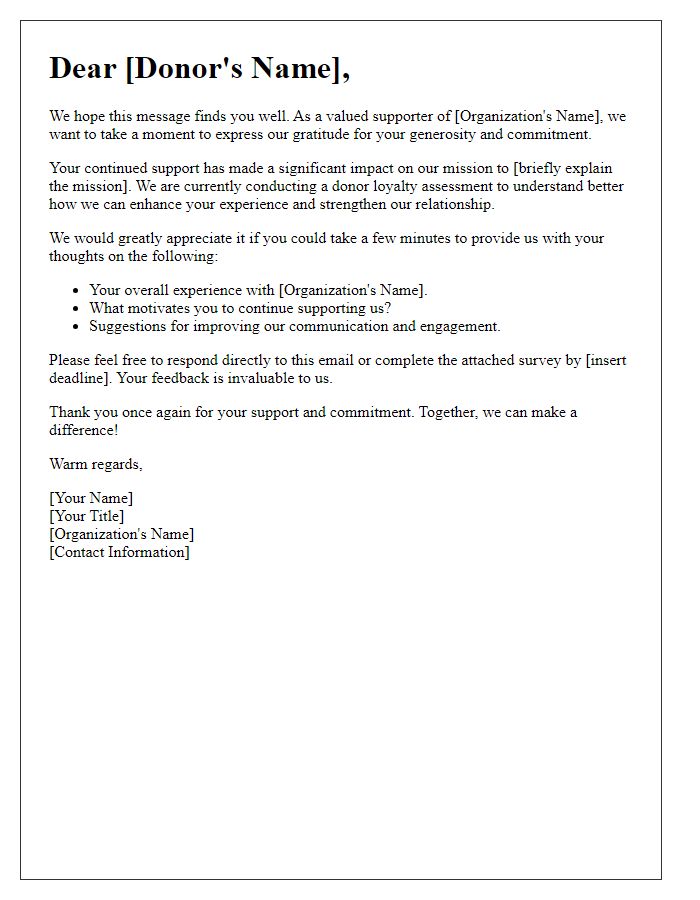Are you passionate about making a difference? We want to hear from you! Your insights as a donor are invaluable, and we're eager to understand your experience and how we can enhance our engagement with you. Join us in this journey of continuous improvement by participating in our donor engagement surveyâyour voice matters, and we invite you to read more to learn how you can contribute!

Personalized Salutation
Personalized salutation enhances donor engagement by establishing a connection through the recipient's name. Addressing donors individually can increase their willingness to participate in surveys aimed at improving outreach and support strategies. Recognizing their contributions fosters a sense of belonging and appreciation within the organization, ultimately leading to higher response rates and more meaningful feedback. Including specific details, such as their donation history or involvement in specific events, can further personalize the experience and reinforce their value to the nonprofit.
Clear Purpose Statement
A clear purpose statement for a donor engagement survey emphasizes the importance of understanding donor experiences and preferences. This survey aims to gather valuable insights from donors regarding their engagement levels, motivations, and satisfaction with our organization, which can include charities or nonprofits. Feedback received will serve as a foundational tool for enhancing our outreach initiatives and cultivating stronger relationships. By analyzing responses, our goal is to improve communication strategies and fundraising efforts, ensuring that we meet donor expectations and continue to foster a community of support essential for our mission's success.
Concise Survey Instructions
Engaging donors requires understanding their perspectives. Utilize concise survey instructions to gather valuable insights. Start by emphasizing the purpose of the survey (improving donor relations and contributions). Specify the estimated time commitment (approximately 5-10 minutes). State anonymity guarantees to encourage honest feedback. Include clear guidelines on survey completion, such as preferred digital formats (online platforms like Google Forms or SurveyMonkey). Provide a deadline for submission (e.g., two weeks from distribution date) to enhance urgency. Offer incentives, if applicable, such as entry into a prize draw for completed surveys. Express gratitude for their participation and reinforce the impact of their contributions, ensuring they feel valued and engaged.
Expression of Gratitude
Donor engagement surveys play a crucial role in nonprofit organizations' efforts to understand supporters' perspectives. Gathering insights from donors enables organizations to tailor communication and improve fundraising strategies. Respondents, such as individual philanthropists and corporate sponsors, contribute invaluable feedback that helps shape future initiatives. By expressing gratitude, organizations foster stronger relationships, which can lead to increased future donations. Understanding donor motivations, preferences for engagement, and feedback on past campaigns can significantly enhance overall satisfaction and loyalty.
Contact Information for Queries
Contacting potential donors requires careful consideration of their preferences and concerns. Engaging these supporters, especially through surveys, is critical for understanding their motivations and improving future campaigns. Providing clear contact information ensures that donors feel comfortable reaching out with any questions or feedback about the survey. Having dedicated email addresses (e.g., donorrelations@nonprofitorganization.com) or phone lines (e.g., +1-800-555-0199) staffed by knowledgeable representatives during business hours enhances trust. Including responsiveness timelines, such as answering queries within 48 hours, can also encourage participation and establish a sense of reliability. Offering multiple avenues for communication, whether through social media platforms like Twitter or Facebook, can accommodate different donor preferences and improve overall engagement.













Comments